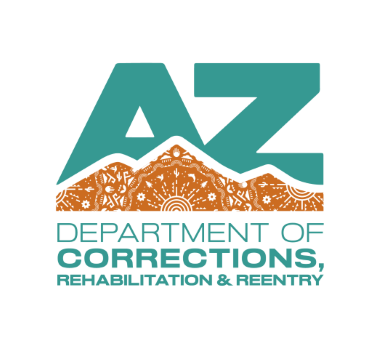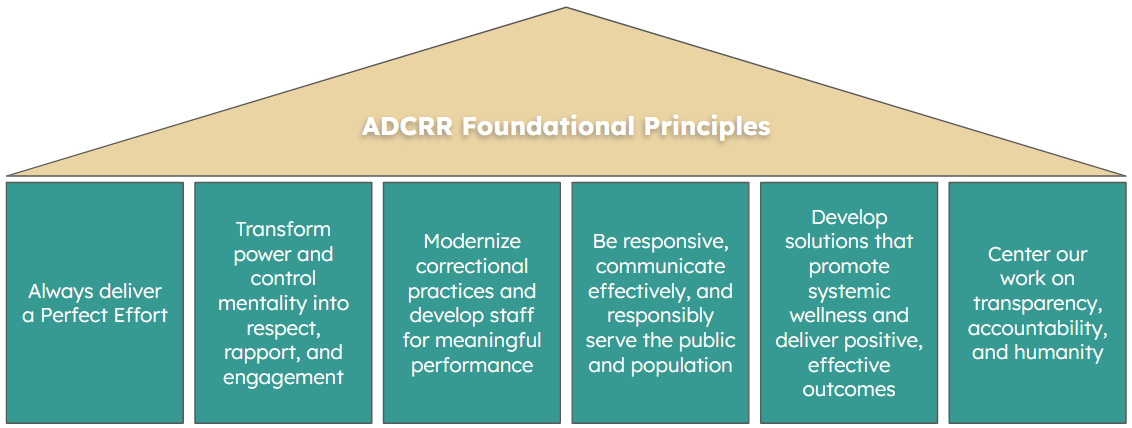
2025 Mission and Vision
“Our mission is to enhance public safety across Arizona through modern, effective correctional practices and meaningful engagements.”
Goal 1: Build a Meaningful Organizational Culture & Promote the Development of Team
Strategies and Initiatives
-
1.1Foster a culture of continuous learning, collaboration, and engagement by enhancing professional development opportunities and strengthening team dynamics to improve effectiveness
-
1.2Continue deploying staff professional development academies focused on core job responsibilities, personal growth, and modern correctional practices
-
1.3Increase leadership growth opportunities by 20% through development and implementation focused on supervisor mentorship programs, advanced leadership training, and promotional preparation efforts
-
1.4Emphasize and encourage consistent communication and information-sharing across the Department and between divisions through targeted town halls and new division-specific communication forums
-
1.5Prioritize clear, respectful, person-centered communication across ADCRR by implementing an initiative to create a more respectful and supportive culture, enhance staff and individual interactions, and align communication strategies with modern correctional practices
-
1.6Increase staff's awareness and engagement with wellness-based resources, including EAP and HIP initiatives
-
1.7Implement a smoke-free initiative, eliminating smoking across ADCRR, promoting overall wellness and a healthier environment while aligning with public health best practices
-
1.8Reimagine ADCRR's Correctional Officer Training Academy (COTA), ensuring new cadet training addresses the priorities of the Department and best correctional practices
-
1.9Sustain the early success of the 2024 security series Field Training Officer and Evaluation Program by fully implementing the program at all prison complexes and increasing participation by 15%
-
1.10Target staff wellness and support strategies using staff survey results and information
-
1.11Transition from sanction-focused staff accountability to a balanced, wellness, and coaching-focused staff accountability
-
1.12Promote an expanded use of 'on the spot' recognitions, team building activities, and other staff-suggested strategies to strengthen staff retention
Goal 2: Create and Implement Optimal Population Management & Progression Strategies
Strategies and Initiatives
-
2.1Implement the Ohio Risk Assessment System (ORAS) to guide meaningful programming placement, individualized case management services, and community reentry
-
2.2Further implement housing and custody strategies to improve the management, health, and safe integration of the inmate population
-
2.3Align detention and restrictive housing practices with modern correctional standards to prioritize safety, ensure transparency, and promote fairness and rehabilitation
-
2.4Decrease the Department's use of detention housing for protective custody placements by 15%
-
2.5Reimagine the systemic role of the Pima Reentry Center (PRC) and Maricopa Reentry Center (MRC) in supporting safe transition services in the community, increasing bed utilization by 25% at each center
-
2.6Expand the size, scope, and impact of the Contraband Interdiction Task Force (CITF), including the implementation of mail scanning services in at least 50% of housing units
-
2.7Establish the Violence Reduction Task Force, focused on strengthening housing placement decisions to improve safety, security, and daily operations
-
2.8Implement the results and recommendations of the Classification Workgroup, following the completion of the pilot program and evaluation phase
-
2.9Strengthen volunteer partnerships and services in prisons and in community offices, increasing the number of approved volunteers by at least 50 volunteers
-
2.10Expand access to education, apprenticeship, and workforce development programs aiming to reduce recidivism by providing individuals with the skills and tools for successful reentry
-
2.11Implement co-led educational, vocational, and rehabilitative programs facilitated by staff and the population together fostering mutual respect, communication, skill-building, and rehabilitation
Goal 3: Deploy Quality Service Delivery & Continuity of Care in Complexes & Communities
Strategies and Initiatives
-
3.1Continue demonstrating progress towards substantial compliance in Jensen v. Thornell
-
3.2Expand the Department's emergency preparedness through regular and meaningful division-specific and statewide exercises
-
3.3Reimagine the prison visitation process to streamline access, enhance security protocols, and promote meaningful interactions
-
3.4Implement absconder reduction strategies, aiming to reduce community reentry absconding behavior by 10%
-
3.5Implement, train, and coach case management principles and reentry planning techniques for correctional officer case management staff
-
3.6Increase the role and utilization of peer support specialists across all prison housing units and populations, ensuring integration into service delivery and support, enhancing individual engagements, and supporting staff efforts
-
3.7Create a feasible plan for increasing the effectiveness of the Transition Program, improving the program's successful completion rate by 15%
-
3.8Implement community reentry supervision strategies focusing on staff training and wellness, community partnerships, and increasing outcomes to promote individual success and well being
-
3.9Evolve Arizona Corrections Industries (ACI) into a workforce training hub, in concert with Education, Programs, and Community Reentry (EPCR), to increase employability opportunities for incarcerated individuals prior to and upon release from prison
Goal 4: Achieve Modernization and Sustainability of Practices and Resources
Strategies and Initiatives
-
4.1Emphasize and promote workplace efficiency by leveraging technology and automation
-
4.2Implement a meaningful policy revision process that promotes active involvement of staff and leadership, implements efficiencies, and ensures clarity, fairness, and effectiveness
-
4.3Further automate Jensen-related data collection strategies
-
4.4Implement real-time, rapid deployment of teams to address facility maintenance and repair
-
4.5Develop and implement a meaningful and timely use of force review process, emphasizing proper practices through coaching and support for staff
-
4.6Consolidate central office staff and resources into one headquarters location
-
4.7Modernize the inmate grievance and disciplinary processes, developing practices that are efficient and timely, meaningful, and measurable
-
4.8Reimagine the recruitment and hiring process for new employees, focusing on efficiency, attracting qualified candidates, and shortening the timeline-to-hire (to under 30 days) to better meet operational needs and support workforce growth
-
4.9Redesign the employee promotional process to ensure transparency and alignment with the Department's mission, vision, and principles
-
4.10Efficiently invest in ADCRR's aging infrastructure to preserve safety, security, and usefulness
-
4.11Sustain the Department's implementation of the Extreme Heat Safety and Relief Strategy
-
4.12Enhance the grant review process, adding innovation and modernization, ensuring optimization of opportunities aimed to support the Department
-
4.13Develop and implement a public-facing records portal for easier access to inmate education records, certifications, and training documentation following release and reentry into the community
